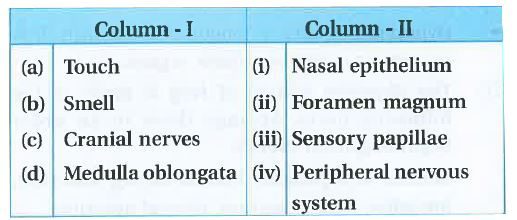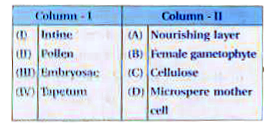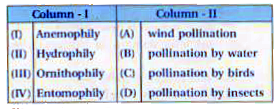Which of the following statements describe natural extinction ?
(i) Extinctions abetted by human activities
(ii) Slow replacement of existing species
(iii) Also known as background extinction
(iv) A small population is most likely to be extinct
(a) (i) and (ii)
(b) (i), (ii) and (iii)
(c) (ii), (iii) and (iv)
(d) (i), (ii), (iii) and (iv)
(i) and (ii)
(i), (ii) and (iii)
(ii), (iii) and (iv)
(i), (ii), (iii) and (iv)
The correct Answer is:C
To determine which statements describe natural extinction, we will analyze each statement one by one:
1. Statement (i): Extinctions abetted by human activities
- This statement refers to anthropogenic (human-caused) extinctions, which are not considered natural extinction. Natural extinction occurs without human influence. Therefore, this statement is incorrect.
2. Statement (ii): Slow replacement of existing species
- Natural extinction can involve the gradual replacement of existing species over time. This process is part of the natural evolutionary cycle. Thus, this statement is correct.
3. Statement (iii): Also known as background extinction
- Natural extinction is often referred to as background extinction, which is the standard rate of extinction in Earth's history. Therefore, this statement is correct.
4. Statement (iv): A small population is most likely to be extinct
- Smaller populations are indeed more vulnerable to extinction due to factors like genetic drift, inbreeding, and environmental changes. Hence, this statement is also correct.
Now, summarizing the correctness of the statements:
- Statement (i) is incorrect.
- Statements (ii), (iii), and (iv) are correct.
Based on this analysis, the correct option is:
(c) (ii), (iii), and (iv).
- This statement refers to anthropogenic (human-caused) extinctions, which are not considered natural extinction. Natural extinction occurs without human influence. Therefore, this statement is incorrect.
- Natural extinction can involve the gradual replacement of existing species over time. This process is part of the natural evolutionary cycle. Thus, this statement is correct.
- Natural extinction is often referred to as background extinction, which is the standard rate of extinction in Earth's history. Therefore, this statement is correct.
- Smaller populations are indeed more vulnerable to extinction due to factors like genetic drift, inbreeding, and environmental changes. Hence, this statement is also correct.
- Statement (i) is incorrect.
- Statements (ii), (iii), and (iv) are correct.
(c) (ii), (iii), and (iv).
Topper's Solved these Questions
- BIODIVERSITY & CONSERVATIONBOOK - NCERT FINGERTPS ENGLISHCHAPTER - BIODIVERSITY & CONSERVATIONEXERCISE - HOTS
5 Videos
- BIODIVERSITY & CONSERVATIONBOOK - NCERT FINGERTPS ENGLISHCHAPTER - BIODIVERSITY & CONSERVATIONEXERCISE - NCERT (EXEMPLAR PROBLEMS
20 Videos
- BIOTECHNOLOGY - PRINCIPLES AND PROCESSESBOOK - NCERT FINGERTPS ENGLISHCHAPTER - BIOTECHNOLOGY - PRINCIPLES AND PROCESSESEXERCISE - Biotechnology - Principles And Processes
139 Videos
Similar Questions
Where would the greatest number of endemic species occur and why ?
(a) Small volcanic archipelagos, such as the Galapagos Islands, because the abundance of unoccupied habitats favours the adaptive divergence of colonists from nearby mainland populations.
(b) Large oceanic island, such as Australia, because the inhabitants have been isolated from mainland populations for a very long time.
(c) On rugged landscapes, such as Patagonia, because of the high levels of natural disturbance by glaciers and earthquakes.
(d) Temperate woodlands, such as those in southern England, because of the high levels of disturbance by human activity and the history of artificial selection.
View SolutionWhich of the following countries has the highest biodiversity?
(a) Brazil
(b) South Africa
(c) Russia
(d) India
View SolutionWho is the father of genetic engineering?
View SolutionAccording to IUCN, some of the extinctions inclide
(i) Dodo
(ii) Indian gazelle
(iii) Thylacine
(iv) Steller's sea cow
View SolutionMatch the column-
Column IColumn IIA Toxinsi. MorphineB Alkaloidsii. AbrinC Lectinsiii. VinblastinD. Drugsiv. Concanavalin A
ABCDiiiiiiiviiiiiiiviiiiviiiviiiiii
View Solutionनिम्न में से कौन सा कथन प्राकृतिक विलुप्तिकरण को वर्णित करता है ? ( i ) मानव क्रियाओं से होने वाले विलुप्तिकरण
( ii ) उपस्थित जातियों का धीमा विस्थापन
( iii ) इसे बैक ग्राउण्ड विलुप्तिकरण भी कहते हैं
( iv ) एक छोटी समष्टि / जनसंख्या की विलुप्त की संभावना अधिक होती
View SolutionMatch the followings and choose the correct answer. (A) (a - ii), (b - iii), (c - iv), (d - i) (B) (a - iii), (b - ii), (c - iv), (d - i) (C) (a - i), (b - iii), (c - ii), (d - iv) (D) (a - ii), (b - iv), (c - iii), (d - i)
View SolutionMatch the following with reference to cockroach and choose the correct option. (A) (a - iii), (b - iv), (c - ii), (d - i) (B) (a - iv), (b - iii), (c - ii), (d - i) (C) (a - iv), (b - ii), (c - iii), (d - i) (D) (a - ii), (b - iv), (c - iii), (d - i)
View SolutionMatch the followings and choose the correct answer.

(A) (a - iii), (b - i), (c - ii), (d - iv)
(B) (a - ii), (b - i), (c - iv), (d - iii)
(C) (a - iii), (b - iv), (c - ii), (d - i)
(D) (a - iii), (b - i), (c - iv), (d - ii)
View SolutionMatch the two columns: (A) (I-A),(II- B), (III- D), (IV- C) (B) (I-B), (II-A), (III-D), (IV - C) (C) (I- A), (II-B), (III-C), (IV- D) (D) (I- D), (II- A), (III-C), (IV-B)
View SolutionMatch the two columns:

(A) (I-C), (II-D), (III-B), (IV-A)
(B) (I-D), (II-C), (III-A), (IV-B)
(C) (I-C), (II-B),(III-D), (IV-A)
(D) (I-B),(II-D),(III-C),(IV-A)
View SolutionMatch the two columns:

(A) (I-A), (II-B), (III-C), (IV-D)
(B) (I-B), (II-A), (III-C), (IV-D)
(C) (I-A), (II-C), (III-B), (IV-D)
(D) (I-D), (II-B), (III-C), (IV-A)
View SolutionAccording to IUCN, some of the extinctions include
(i) Dodo
(ii) Indian gazelle
(iii) Thylacine
(iv) Steller's sea cow
(a) (i), (ii), (iii) and (iv)
(b) (ii) and (iv)
(c) (i),(iii) and (iv)
(d) (iii) and (iv)
View SolutionBiodiversity loss occurs due to
(i) habitat loss and fragmentation
(ii) co-extinction
(iii) over-exploitation
(iv) alien species invasion.
(a) (i) and (ii)
(b) (i), (ii) and (iii)
(c) (ii), (iii) and (iv)
(d) (i), (ii), (iii) and (iv)
View SolutionWhich of the following statements describe natural extinction? A. Extinetions abetted by human-activities. B. Slow replacement of existing species C. Also known as background extinction D. A small population is most likely to be extinct.
View Solutionनिम्नलिखित में किस एक प्राणी को किसान का मित्र कहा जाता है?
View Solution
